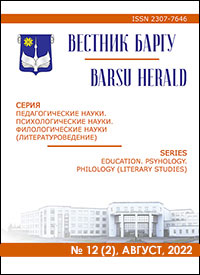FOREIGN LANGUAGE COMMUNICATIVE COMPETENCE FORMATIONOF FUTURE PRESCHOOL EDUCATION SPECIALISTS IN THE CONDITIONSOF ADDITIONAL EDUCATION OF CHILDREN
Keywords:
foreign language communicative competence; communicative competency; communication skills; communicative culture; future preschool education specialists; additional education for childrenAbstract
The article deals with the concepts of “communicative competence” and “communicative competency”. The model
of foreign language communicative competence of future preschool education specialists is described. The motivational,
cognitive and behavioral components of foreign language communicative competence, general and special communicative skills of future preschool education specialists are characterized. The types of communicative skills that make up foreign language communicative competence are distinguished: perceptual, expressive, self-regulation, technical. The essence of communicative culture is revealed and the forms of its manifestation are described. A number of regularities and principles for the development of foreign language communicative competence among future specialists in preschool education have been identified: the integrity and adequacy of professional ideas, the integrity of the motivational, cognitive and behavioral
components of communicative competence, the activity and awareness of the student, the use of language as a means of communication, the focus of training on solving the problems of the professional sphere.
Fig. 1. Ref.: 17 titles.
Downloads
Published
Issue
Section
License
Copyright (c) 2023 Вестник БарГУ Серия "Педагогические науки. Психологические науки. Филологические науки"
Это произведение доступно по лицензии Creative Commons «Attribution-NonCommercial» («Атрибуция — Некоммерческое использование») 4.0 Всемирная.
Авторы сохраняют за собой право заключать определенные договорные соглашения, касающиеся неисключительного распространения опубликованной версии работы (например, размещать ее в институциональном репозитории, публикация в книге) со ссылкой на ее первоначальную публикацию в этом журнале.





